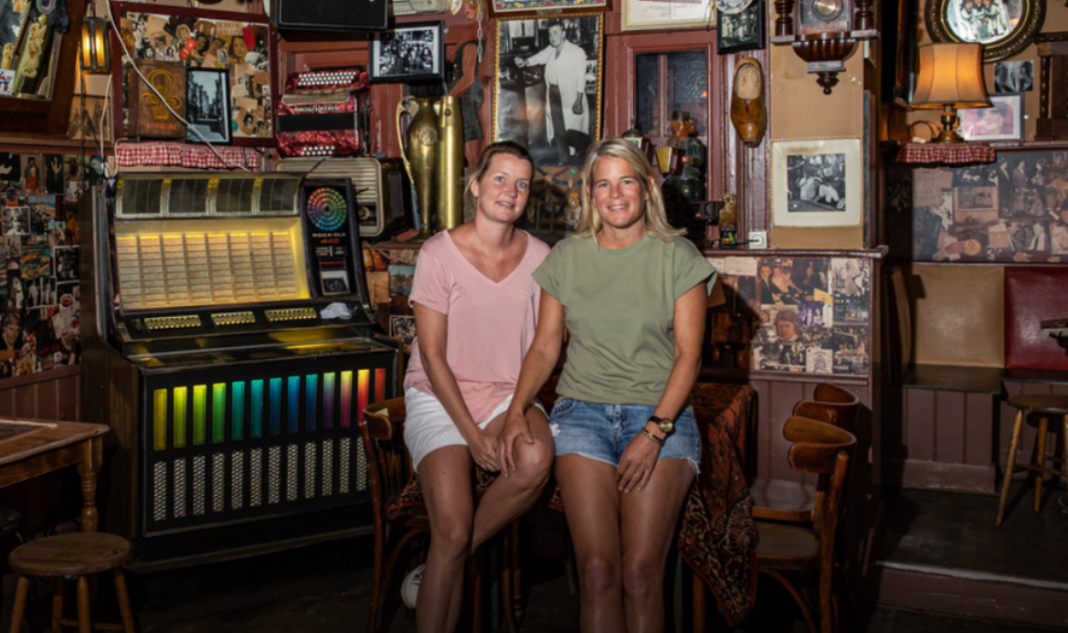The legendary Amsterdam café founded by an out lesbian in 1927—yes, that’s almost 100 years ago—is now once again being run by out lesbians after a deal signed last year. And the agreement that handed control of Café ’t Mandje (Zeedijk 63, Amsterdam) over to Laura Molenkamp and her partner Marinda Filk ensures that the business will maintain a similar look and feel for yet another 100 years.
But there’s no reason to wait a century to make a pilgrimage to one of the world’s trail-blazing queer spaces. Stepping inside Café ’t Mandje, which means “little basket,” is like stepping back in time. There’s no need to see the exhibit about it in the Amsterdam Museum. Café ’t Mandje itself is a museum—though one where you can drink cocktails, sing karaoke and flirt with the hotties at the next table.
“We are not allowed to change things in the bar, well, except for maintenance or moving a sign,” says Molenkamp. “The woman who started the bar, Bet van Beeren, she didn’t change a lot, so it’s almost the same as when she opened it in 1927. If you see pictures from then and now, there is not much difference. You’ll see many things hanging on the ceiling with a story and a lot of the stories we don’t know. We do know some.”
Van Beeren, born in 1902, was already out when she took over the café at age 25. “She openly welcomed gays, lesbians and others, in times when homosexuality was not commonly accepted, to mingle with the sailors, neighbours, artists and intellectuals who also frequented the little bar,” states the bar’s website. “Men danced with men, and women danced with women.” In the 1950s, when police started poking around more, van Beeren had an owl statue on the bar. When a raid was imminent, she’d light up the eyes of the owl as a warning signal. “Then people knew they could not dance with each other and they would switch to dancing in heterosexual couples,” says Molenkamp.
Van Beeren’s taste was eclectic and a bit packratty—the décor commemorates the people and the trends of the times: cut-off men’s ties and underwear still hang from the ceiling, there’s an accordion on the jukebox. There are lots and lots of photos. And at least four pairs of shoes.
“Sometimes you had someone at the bar drinking and they didn’t want to pay the bill, or they couldn’t pay the bill,” says Molenkamp. “She thought, ‘Oh, I don’t want you to do the same in another bar. So I keep your shoes so you cannot go into another bar.’ There was also a chance that they came back to pay the bill the next day and get their shoes.”
Van Beeren died in 1967, leaving the bar to her younger sister Greet, who kept the place going until 1981. Greet closed the bar down as the surrounding area got seedier. Zeedijk, though one of Amsterdam’s most historic streets, is located at the edge of the red-light district and there was increasing drug use in the area. After keeping the place dark for almost three decades, Greet sold the bar to her cousin Diane who, following extensive renovations, reopened Café ’t Mandje in 2008. Though it continued to attract curious queers, being a stop on tours of the red-light district might have straightened the vibe; the bar closed in 2019 during pandemic lockdowns.
In 2020, the building was sold to the investment firm NV Zeedijk. Though that might sound like a cause for capitalist panic, the organization is 78 percent controlled by the city of Amsterdam and is dedicated to maintaining the character and improving the communities of its properties. NV Zeedijk’s goal with Café ’t Mandje seems to be making the business and the street more welcoming to its original constituency—queers. A boutique hotel will be opened on the upper floors.
Molenkamp and Filk, who had previously run a sandwich shop down the street, signed a contract to manage the bar and relaunched in July 2022, agreeing to maintain the bar’s cultural heritage. (Behind the scenes, a possible partner that Molenkamp and Filk wanted to run the business with passed away during negotiations.) Their main modernization has been in the staffing and programming. Opening at 4pm daily, there are performances, singalongs and student nights throughout the month.
The couple runs the bar two nights a week, giving the place a woman-friendly atmosphere, while “the boys” on staff run things the other nights. There’s dancing Fridays and Saturdays after 9pm, with the rest of the week more relaxed and community-oriented. “Whether it’s more men or women depends on the night, but it’s always really mixed,” says Molenkamp. “Even back in the day, though it was run by a lesbian, it was always mixed.”
Because the bar has a capacity of about 45, she says it can have a bustling energy even with five or 10 people inside. “I would say we get about 20 percent tourists and 80 percent locals, not just from Amsterdam but from all around Holland. People love the atmosphere.”


